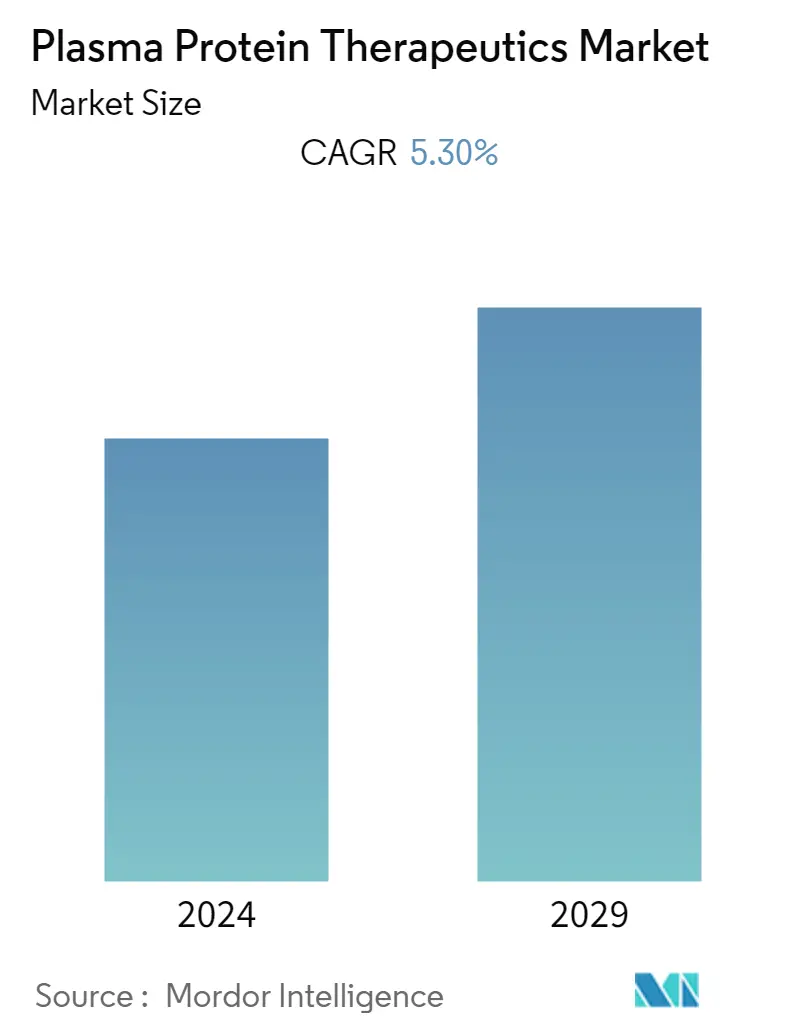Market Size of Plasma Protein Therapeutics Industry

| Study Period | 2021 - 2029 |
| Base Year For Estimation | 2023 |
| Forecast Data Period | 2024 - 2029 |
| CAGR | 5.30 % |
| Fastest Growing Market | Asia-Pacific |
| Largest Market | North America |
Major Players
*Disclaimer: Major Players sorted in no particular order |
Need a report that reflects how COVID-19 has impacted this market and its growth?
Plasma Protein Therapeutics Market Analysis
The plasma protein therapeutics market has been projected to register a CAGR of 5.3% over the forecast period.
The COVID-19 pandemic significantly impacted the plasma protein therapeutics market during the initial phase because of factors such as reduced plasma donations, shutdowns of laboratories and testing centers, and restrictions on medicine import and export. However, the sector has been recovering well since restrictions were lifted. The market is expected to grow due to increased plasma protein therapeutics product launches and associated research studies.
The major factors leading to the market's growth include the increasing prevalence of autoimmune disorders, immune deficiency disorders, neurological and bleeding disorders, and the rise in research and development in plasma protein. For instance, as per the 2022 update from NHF, approximately 400 male babies are born with hemophilia A every year. Furthermore, the growing investments in research & development programs by biotechnology and pharmaceutical companies are boosting the market growth. For instance, in November 2021, Biognosys launched the Next-Generation blood biomarker discovery solution. The improved service offers unprecedented depth, precision, and throughput, quantifying up to 3,000 proteins in plasma or serum.
Moreover, beneficial government initiatives, escalating awareness levels among blood donors, advanced protein fractioning procedures, greater per capita income in developed countries, and increased research partnerships are some of the drivers expected to increase market growth in the region. For instance, in October 2022, the Department of Health and Human Services (HHS) launched an innovation challenge to identify effective, evidence-based strategies to increase blood and plasma donations through sustainable, community-driven approaches. The challenge is part of HHS's 'Giving=Living campaign,' which aims to raise awareness of the importance of donating blood and to encourage Americans to develop new, regular donation habits. In October 2022, The ISBT Working Party on Global Blood Safety initiated the ICSPP as a global coalition to advance access to safe plasma proteins in Low- and middle-income countries. The alliance is likely to support national initiatives in stepwise plasma quality, safety, and volume enhancement; local small-scale synthesis of virus-safe clotting factors and immunoglobulins; and advancement of industrial plasma fractionation in collaboration with the WHO. Hence, such government initiatives are likely to increase the awareness and demand for plasma protein therapeutics, thereby boosting market growth over the forecast period.
Therefore, the studied market is predicted to grow over the forecast period due to the surge in plasma protein research and development and the incidence of autoimmune disorders, immune deficiency disorders, neurological disorders, and bleeding disorders. However, the stringent regulations for handling plasma protein products and the lack of proper reimbursement policies are the major drawbacks expected to hinder the market growth.
